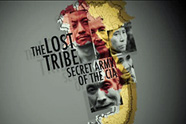Out of the jungle
Part two of Tony Birtley’s account of the lost tribe of Laos.
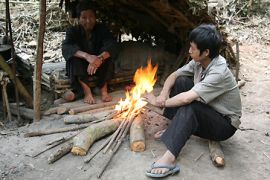
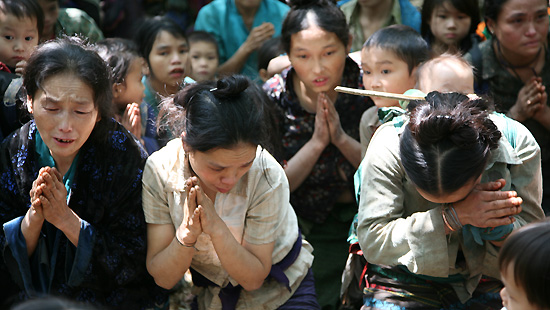 |
| The Hmong say more than half a million have died since 1975 [Photo: Tony Birtley] |
Al Jazeera’s correspondent Tony Birtley travelled in secret to the jungles of northern Laos in search of the last fighters of the CIA’s “secret army”, a remnant from the days of the Vietnam War. This is part two of his account of the journey.
| The Lost Tribe |
|
|
The Hmong leader, Vang Che Chi, told me that since 1975 the Laos army had killed 598,000 Hmong.
Every year their villages were raided and they were forced to live on the run, he said, staying in one place for only a few weeks at a time, sometimes for only a day.
He had carefully documented notebooks kept in worn plastic bags, which he said held the names of many who had been murdered.
It is impossible to verify what he was telling me, but human rights groups have long documented accounts from Hmong refugees of suffering at the hands of the Laos army.
As I walked around the settlement people would immediately drop to their knees in an act of worship, chanting something to me. The translator said each time they would end the chant by begging me for help.
When I lay down in a bamboo shelter they had made especially for me, together with a holder and tooth picks on one of the poles, I listened to my Ipod.
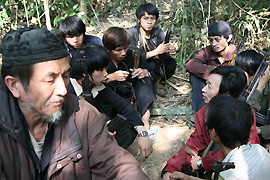 |
| Hmong leader Vang Che Chi, left, says without help the Hmong will all die [Photo: Tony Birtley] |
Children gathered around, mesmerised by the music, stunned by the photographs it contained. Half dressed in rags, barefoot and with dirty faces, life had left them behind.
Each one had lost someone they said had been killed by the army, each adult at some stage broke down and cried before me, even the leader, even the toughest looking fighter.
They carried lists around with them of the family they had lost. One man produced a piece of paper containing 75 names of those he said had been murdered.
Another young woman told of how her husband had been killed last year before seeing his newborn baby daughter. She was almost defeated: with no husband and a young baby to look after, the desperate search for food took on a new dimension.
Survival depends largely on a plant root they call qo – a potato like food, but drier and served boiled or steamed as a paste and hard to stomach for someone like me. If they are lucky they eat this three times a day. If not, less.
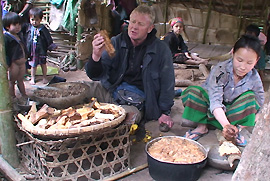 |
| The Hmong survive on basic plant root found in the jungle [Photo: Tony Birtley] |
To find qo they have to dig down up to four metres and walk up to three hours to find it – a journey which often leads to deadly encounters with the Laos army.
For Hmong men life is spent constantly on guard, rarely without their weapons.
Their weapons are mostly 30-years-old or even older. Russian Kalashnikovs, American M16s and grenade launchers from the Vietnam War era and even some carbines dating back to the second world war.
At night the temperature plummets in the highland jungle and I was woefully ill prepared for it. I wasn’t able to sleep more than two hours without having to get up and stand over a fire. At least the jungle had a plentiful supply of firewood.
When you asked people how they had been affected by the situation they tended to show, rather than tell.
People like the old lady who took off her top to show me the three bullet wounds suffered when she was looking for food.
 |
| Many of the Hmong men carry the scars of years of fighting [Photo: Tony Birtley] |
Or the 65-year-old man left with a stump for a leg after he stood on a mine. Now he has a crude rubber and bamboo cup into which he puts his stump and with the aid of a stick fashioned into a crutch, he hobbles around.
Another woman showed me her leg, horribly disfigured, she says from a bullet wound. She moved part of the flesh and they told me this was the bullet still moving around.
The Hmong have no medical supplies, no surgical instruments. They live and die in the jungle, everything they have comes from the jungle.
The leader, Vang Che Chi, spoke to me again. He said I still had to stay but explained the depths of despair to which they had plunged.
“We don’t want to go to America or France,” he told me. “And we don’t want to go to the refugee camps in Thailand. We want to stay here but to live in peace, to grow crops, for the old to spend their last days, as old people should.
“We cannot surrender to the Laos government. Those who have done before disappeared or were imprisoned, or were used to hunt other Hmong. We do not trust the communists.”
He told me that in 1975 he was leader of 18,000 Hmong but now only 7,000 remain.
“Unless we get help, we will all die,” he told me sternly.
My translator tapped me on the shoulder. “She would like to see your photographs,” he said, pointing to a shy, beautiful girl with a big wide smile. She was 11-years-old but I noticed her hands were bony and red, the signs of work. They were the hands of someone much older.
She wanted to see pictures of my family. I obliged showing photos of my kids in hotels, at dinner, at the beach, at parties – things this girl could have never dreamed of and was only now seeing for the first time.
“Beautiful,” she said as she saw a photo of my six-year-old girl. I was starting to get emotional. I asked her what she wanted from life and she told me: education.
|
America came into Laos and asked us for help in the war against Vietnam. But America has taken away our elders and people and left us behind |
I asked her if she knew what that was. No, she answered, “but my mother tells me it is good”.
According to Vang Che Chi there are only a handful of former Hmong CIA fighters left in the jungle.
He seemed a little embarrassed by the subject because this is the reason why the Hmong have allegedly been persecuted all these years.
Nestling a US army issue grenade launcher in his arms, one fighter named Kiayeng told me of the days he fought the Vietnamese.
He joined the CIA’s “secret army” in 1961, saw action many times and lost his son in battle.
He is 63 now and more often he cradles a bamboo pipe where he smokes a kind of tobacco found in the jungle.
“I help America a lot,” he told me. “But it is not important for America. I am disappointed with them. I am old but I still have this gun to protect my family. Thee sons and one daughter were killed by the communists.”
Another fighter named Xiong proudly displayed his M16 rifle. “Me CIA solider,” he said in the only English he knew.
“America came into Laos and asked us for help in the war against Vietnam. But America has taken away our elders and people and left us behind.”
He was referring to the more than 120,000 Hmong who have been allowed to settle in the US.
“Red Laos was unhappy with us for helping America,” he went on. “They hunt us everywhere. They blame us for being the fruits of America, following the American way and democracy. That’s why they want to destroy us.”
 |
| Decades of conflict have left scores of widows and orphans [Photo: Tony Birtley] |
On the fifth day a woman ran through the village distraught. Her father had been killed she said while he walked to the village. It started a controlled panic.
“Laos army might come,” my translator said. “We must pack our things.”
My release was looking less likely by the day. The whole village packed up what belongings they had, putting them into baskets and old knap sacks.
Young fighters went running to check security. There was a sense of foreboding. The Hmong have gone through this many times. It was my first, and I began to wonder what would happen should the Laos soldiers find us and me, an outsider and a witness to their suffering.
After standing by for several hours, the emergency passed. The fighters returned to declare that the army was not coming. People unpacked and went back to what passes for normality in their impoverished existence.
By now my frustration had grown to the extent that I said I was going to leave by myself, taking my chances and testing what the Hmong would do.
The women of the village panicked. Thirty of them, along with their children appeared by my lean-to, baskets packed.
“They want to come with us,” said the translator.
“They can’t, it’s too dangerous,” I said. “What about the soldiers, they could get killed.”
A woman who looked 70 but in reality was 50, looked at me. “We can die here or with you, it doesn’t matter. But if you go we want to go with you. We cannot stay here anymore. We cannot stand anymore.”
A heated debate followed with the men joining in, questioning whether they should let me go or all follow me back to civilisation. Eventually it subsided, the angry expressions replaced with smiles and my release began to look a real possibility.
They slaughtered one of their few chickens for me, examining the bones for auspicious signs. “A good one,” declared the leader.
 |
| The Hmong say they just want to live in peace and without fear [Photo: Tony Birtley] |
I gave them what little food I had. Some cheese, tinned ham and biscuits for the children. It was rich food compared to what they ate but they seemed to like it. It did not change their situation one bit, but selfishly it made me feel better.
On the day before I was finally allowed to leave two men came to the settlement. They had walked for two days from another village to see me.
They dropped to their knees in front of me and begged me for help, to save them. They cried, sobbing like children. One man was 40 and, while he carried a gun, he had the expression of a helpless child.
“I am from Moua family,” he explained. “Five hundred members of our family have been killed and we now have only 53 family members left. You are a representative from a big country, could you please consider saving us as well?”
The innocence of the request struck me. The naivety of this man before me, the desperation, and the reality that I could do nothing apart from tell their story.
People began to come to me to ask if there was anything I could give them. The old CIA man, now with his pipe and not the grenade launcher, shook my hand. “Please help us,” he said. “I want to see a city before I die.”
This jungle for the Hmong is a place of nightmares and dreams, the nightmare of what their life is and the dream of what they want it to become, safe.
And they reluctantly accepted that the Westerner who had spent almost a week with them was not about to instantly change their fortunes.
The village turned out to bid me farewell, dropped to their knees in prayer as the leader blessed our journey, and I followed the young fighters out of the village, beginning the gruelling journey back to civilisation.
After two days we made it back to the dirt road and my lift was waiting.
I shook hand with the young fighters, and then they turned and were gone.
